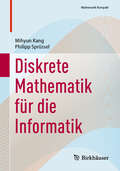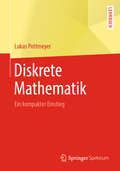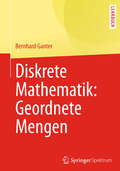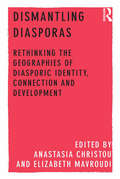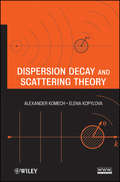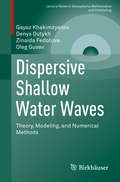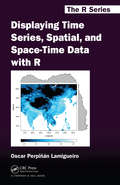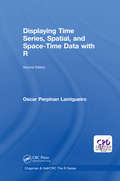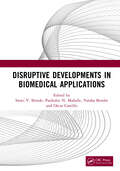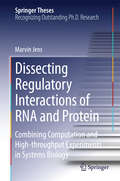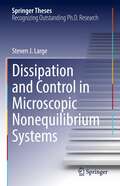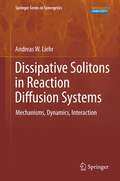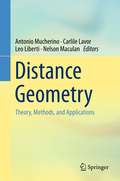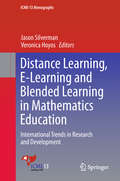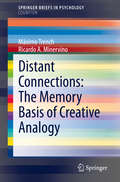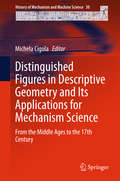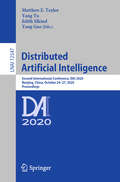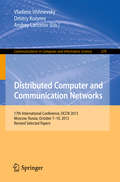- Table View
- List View
Diskrete Mathematik für die Informatik (Mathematik Kompakt)
by Mihyun Kang Philipp SprüsselDieses Buch richtet sich an Studierende in Studienrichtungen der Informatik zu Beginn ihres Studiums. Vorausgesetzt werden daher lediglich Kenntnisse der Schulmathematik. Behandelt werden grundlegende Themen aus dem Bereich der Diskreten Mathematik, mit besonderem Augenmerk auf Algorithmen und Anwendungen. Der Begriff "Diskrete Mathematik" ist hierbei weiter gefasst, als es in Deutschland zumeist üblich ist, und beinhaltet auch Teilbereiche der Zahlentheorie, Logik und erzeugender Funktionen. Selbstverständlich werden mit Abzählmethoden und Graphen auch klassische Themen der Diskreten Mathematik diskutiert. Zahlreiche Beispiele und Übungsaufgaben bieten eine optimale Vertiefung zum Verständnis der Materie an.
Diskrete Mathematik: Ein kompakter Einstieg
by Lukas PottmeyerDieses Lehrbuch gibt in kompakter Form und mit lockerem Stil einen ersten Überblick über zentrale Bereiche der diskreten Mathematik. Es ist zur Verwendung im ersten und zweiten Semester mathematischer Studiengänge geeignet: Sie benötigen als Leser kein tieferes mathematisches Vorwissen und werden behutsam an die mathematische Sprache herangeführt; alle behandelten Themen werden formal sauber und dennoch anschaulich und verständlich eingeführt. Auf ein eigenständiges Kapitel zur elementaren Logik und Beweisstrategien wird verzichtet, denn beides erlernen Sie beim Durcharbeiten implizit. Jedes Kapitel endet mit darauf abgestimmten Übungsaufgaben, deren Lösungen online bereitgestellt werden. Einige besonders zentrale und niedrigschwellige Übungsaufgaben sind explizit gekennzeichnet: Diese sollten Sie nach dem Studium des entsprechenden Kapitels lösen können, bevor Sie zum nächsten Kapitel weiterblättern.
Diskrete Mathematik: Geordnete Mengen
by Bernhard GanterDie Ordnungstheorie ist ein faszinierendes Teilgebiet der Diskreten Mathematik, das praktischen Nutzen und abstrakte mathematische Theorie, anschauliche Überlegungen und schwierige Forschungsprobleme auf manchmal verblüffende Art miteinander verbindet. Das Buch gibt eine motivierende Einführung in Grundbegriffe und moderne Strömungen der mathematischen Theorie geordneter Mengen, wobei der Autor sich auf besonders interessante Themen konzentriert. Da die Ordnungstheorie einfach und anspruchsvoll zugleich ist, abstrakt und angewandt, anschaulich und unvorstellbar, ist sie gerade für Studenten in der zweiten Hälfte des Bachelorstudiums und zu Beginn des Masterstudiums bestens geeignet.
Dismantling Diasporas: Rethinking the Geographies of Diasporic Identity, Connection and Development
by Elizabeth Mavroudi Anastasia ChristouRe-energising debates on the conceptualisation of diasporas in migration scholarship and in geography, this work stresses the important role that geographers can play in interrupting assumptions about the spaces and processes of diaspora. The intricate, material and complex ways in which those in diaspora contest, construct and perform identity, politics, development and place is explored throughout this book. The authors ’dismantle’ diasporas in order to re-theorise the concept through empirically grounded, cutting-edge global research. This innovative volume will appeal to an international and interdisciplinary audience in ethnic, migration and diaspora studies as it tackles comparative, multi-sited and multi-method research through compelling case studies in a variety of contexts spanning the Global North and South. The research in this book is guided by four interconnected themes: the ways in which diasporas are constructed and performed through identity, the body, everyday practice and place; how those in diaspora become politicised and how this leads to unities and disunities in relation to 'here' and 'there'; the ways in which diasporas seek to connect and re-connect with their 'homelands' and the consequences of this in terms of identity formation, employment and theorising who 'counts' as a diaspora; and how those in diaspora engage with homeland development and the challenges this creates.
Dispersal, Individual Movement and Spatial Ecology
by Philip K. Maini Mark A. Lewis Sergei V. PetrovskiiDispersal of plants and animals is one of the most fascinating subjects in ecology. It has long been recognized as an important factor affecting ecosystem dynamics. Dispersal is apparently a phenomenon of biological origin; however, because of its complexity, it cannot be studied comprehensively by biological methods alone. Deeper insights into dispersal properties and implications require interdisciplinary approaches involving biologists, ecologists and mathematicians. The purpose of this book is to provide a forum for researches with different backgrounds and expertise and to ensure further advances in the study of dispersal and spatial ecology. This book is unique in its attempt to give an overview of dispersal studies across different spatial scales, such as the scale of individual movement, the population scale and the scale of communities and ecosystems. It is written by top-level experts in the field of dispersal modeling and covers a wide range of problems ranging from the identification of Levy walks in animal movement to the implications of dispersal on an evolutionary timescale.
Dispersion Decay and Scattering Theory
by Alexander Komech Elena KopylovaA simplified, yet rigorous treatment of scattering theory methods and their applicationsDispersion Decay and Scattering Theory provides thorough, easy-to-understand guidance on the application of scattering theory methods to modern problems in mathematics, quantum physics, and mathematical physics. Introducing spectral methods with applications to dispersion time-decay and scattering theory, this book presents, for the first time, the Agmon-Jensen-Kato spectral theory for the Schr?dinger equation, extending the theory to the Klein-Gordon equation. The dispersion decay plays a crucial role in the modern application to asymptotic stability of solitons of nonlinear Schr?dinger and Klein-Gordon equations.The authors clearly explain the fundamental concepts and formulas of the Schr?dinger operators, discuss the basic properties of the Schr?dinger equation, and offer in-depth coverage of Agmon-Jensen-Kato theory of the dispersion decay in the weighted Sobolev norms. The book also details the application of dispersion decay to scattering and spectral theories, the scattering cross section, and the weighted energy decay for 3D Klein-Gordon and wave equations. Complete streamlined proofs for key areas of the Agmon-Jensen-Kato approach, such as the high-energy decay of the resolvent and the limiting absorption principle are also included.Dispersion Decay and Scattering Theory is a suitable book for courses on scattering theory, partial differential equations, and functional analysis at the graduate level. The book also serves as an excellent resource for researchers, professionals, and academics in the fields of mathematics, mathematical physics, and quantum physics who would like to better understand scattering theory and partial differential equations and gain problem-solving skills in diverse areas, from high-energy physics to wave propagation and hydrodynamics.
Dispersive Partial Differential Equations: Wellposedness and Applications
by M. BURAK ERDO AN Nikolaos TzirakisThe area of nonlinear dispersive partial differential equations (PDEs) is a fast developing field which has become exceedingly technical in recent years. With this book, the authors provide a self-contained and accessible introduction for graduate or advanced undergraduate students in mathematics, engineering, and the physical sciences. Both classical and modern methods used in the field are described in detail, concentrating on the model cases that simplify the presentation without compromising the deep technical aspects of the theory, thus allowing students to learn the material in a short period of time. This book is appropriate both for self-study by students with a background in analysis, and for teaching a semester-long introductory graduate course in nonlinear dispersive PDEs. Copious exercises are included, and applications of the theory are also presented to connect dispersive PDEs with the more general areas of dynamical systems and mathematical physics.
Dispersive Shallow Water Waves: Theory, Modeling, and Numerical Methods (Lecture Notes in Geosystems Mathematics and Computing)
by Denys Dutykh Gayaz Khakimzyanov Zinaida Fedotova Oleg GusevThis monograph presents cutting-edge research on dispersive wave modelling, and the numerical methods used to simulate the propagation and generation of long surface water waves. Including both an overview of existing dispersive models, as well as recent breakthroughs, the authors maintain an ideal balance between theory and applications. From modelling tsunami waves to smaller scale coastal processes, this book will be an indispensable resource for those looking to be brought up-to-date in this active area of scientific research.Beginning with an introduction to various dispersive long wave models on the flat space, the authors establish a foundation on which readers can confidently approach more advanced mathematical models and numerical techniques. The first two chapters of the book cover modelling and numerical simulation over globally flat spaces, including adaptive moving grid methods along with the operator splitting approach, which was historically proposed at the Institute of Computational Technologies at Novosibirsk. Later chapters build on this to explore high-end mathematical modelling of the fluid flow over deformed and rotating spheres using the operator splitting approach. The appendices that follow further elaborate by providing valuable insight into long wave models based on the potential flow assumption, and modified intermediate weakly nonlinear weakly dispersive equations.Dispersive Shallow Water Waves will be a valuable resource for researchers studying theoretical or applied oceanography, nonlinear waves as well as those more broadly interested in free surface flow dynamics.
Displaying Time Series, Spatial, and Space-Time Data with R (Chapman And Hall/crc The R Ser.)
by Oscar Perpinan LamigueiroCode and Methods for Creating High-Quality Data GraphicsA data graphic is not only a static image, but it also tells a story about the data. It activates cognitive processes that are able to detect patterns and discover information not readily available with the raw data. This is particularly true for time series, spatial, and space-time datasets.F
Displaying Time Series, Spatial, and Space-Time Data with R: Displaying Time Series, Spatial, And Space-time Data With R (Chapman & Hall/CRC The R Series)
by Oscar Perpinan LamigueiroFocusing on the exploration of data with visual methods, this book presents methods and R code for producing high-quality static graphics, interactive visualizations, and animations of time series, spatial, and space-time data. Practical examples using real-world datasets help you understand how to apply the methods and code. Each of the three parts of the book is devoted to different types of data. In each part, the chapters are grouped according to the various visualization methods or data characteristics. Recent developments in the "htmlwidgets" family of packages are covered in this second edition with many new interactive graphics.
Disrupting Science: Social Movements, American Scientists, and the Politics of the Military, 1945-1975 (Princeton Studies in Cultural Sociology)
by Kelly MooreIn the decades following World War II, American scientists were celebrated for their contributions to social and technological progress. They were also widely criticized for their increasingly close ties to military and governmental power--not only by outside activists but from among the ranks of scientists themselves. Disrupting Science tells the story of how scientists formed new protest organizations that democratized science and made its pursuit more transparent. The book explores how scientists weakened their own authority even as they invented new forms of political action. Drawing extensively from archival sources and in-depth interviews, Kelly Moore examines the features of American science that made it an attractive target for protesters in the early cold war and Vietnam eras, including scientists' work in military research and activities perceived as environmentally harmful. She describes the intellectual traditions that protesters drew from--liberalism, moral individualism, and the New Left--and traces the rise and influence of scientist-led protest organizations such as Science for the People and the Union of Concerned Scientists. Moore shows how scientist protest activities disrupted basic assumptions about science and the ways scientific knowledge should be produced, and recast scientists' relationships to political and military institutions. Disrupting Science reveals how the scientific community cumulatively worked to unbind its own scientific authority and change how science and scientists are perceived. In doing so, the book redefines our understanding of social movements and the power of insider-led protest.
Disruptive Developments in Biomedical Applications
by Oscar Castillo Parikshit N. Mahalle Swati V. Shinde Varsha BendreThis book covers advancements and future challenges in biomedical application development using disruptive technologies like AI, IoT and signal processing. Book is divided into four main sections namely medical image processing using AI, IoT and biomedical devices, biomedical signal processing and electronic health records including advances in biomedical systems. It includes different case studies of biomedical applications using different AI algorithms related to diabetes, skin cancer, breast cancer, cervical cancer, osteoarthritis, and so forth. Features: Covers different technologies like AI, IOT and signal processing in the context of biomedical applications. Reviews medical image analysis, disease detection, and prediction. Comprehends the advantage of recent technologies for medical record keeping through electronics health records (EHRs). Presents state of art research in the field of biomedical engineering using various physiological signals. Explores different Bio Sensors used in Healthcare Applications using IOT. This book aims at Graduate students and researchers in artificial intelligence, medical imaging, biomedical engineering, and internet of things.
Disruptive Technologies and Optimization Towards Industry 4.0 Logistics (Springer Optimization and Its Applications #214)
by Panos M. Pardalos Athanasia Karakitsiou Athanasios MigdalasThis contributed volume guides researchers and practitioners on resource collaborative management of supply chains and manufacturing enterprises within an industrial internet technological environment. The book comprises 10 chapters that cover two major topics in the subject of logistics 4.0, namely the utilization of both disruptive technologies and optimization techniques in smart logistic management. With global research on the book's topic expanding rapidly across various directions and disciplines, it provides a structured framework for international experts to showcase outstanding work and unique approaches. Researchers and students will find the comprehensive outline on collaborative optimization and management of smart manufacturing and production, warehousing, inventory, logistics, transportation, integrated supply chain, and supply network within the industrial internet platform a beneficial guide to understanding current and future practical problems that arise in manufacturing and supply chain management.
Dissecting Regulatory Interactions of RNA and Protein
by Marvin JensThe work described in this book is an excellent example of interdisciplinary research in systems biology. It shows how concepts and approaches from the field of physics can be efficiently used to answer biological questions and reports on a novel methodology involving creative computer-based analyses of high-throughput biological data. Many of the findings described in the book, which are the result of collaborations between the author (a theoretical scientist) and experimental biologists and between different laboratories, have been published in high-quality peer-reviewed journals such as Molecular Cell and Nature. However, while those publications address different aspects of post-transcriptional gene regulation, this book provides readers with a complete, coherent and logical view of the research project as a whole. The introduction presents post-transcriptional gene regulation from a distinct angle, highlighting aspects of information theory and evolution and laying the groundwork for the questions addressed in the subsequent chapters, which concern the regulation of the transcriptome as the primary functional carrier of active genetic information.
Dissipation and Control in Microscopic Nonequilibrium Systems (Springer Theses)
by Steven J. LargeThis thesis establishes a multifaceted extension of the deterministic control framework that has been a workhorse of nonequilibrium statistical mechanics, to stochastic, discrete, and autonomous control mechanisms. This facilitates the application of ideas from stochastic thermodynamics to the understanding of molecular machines in nanotechnology and in living things. It also gives a scale on which to evaluate the nonequilibrium energetic efficiency of molecular machines, guidelines for designing effective synthetic machines, and a perspective on the engineering principles that govern efficient microscopic energy transduction far from equilibrium. The thesis also documents the author’s design, analysis, and interpretation of the first experimental demonstration of the utility of this generally applicable method for designing energetically-efficient control in biomolecules. Protocols designed using this framework systematically reduced dissipation, when compared to naive protocols, in DNA hairpins across a wide range of experimental unfolding speeds and between sequences with wildly different physical characteristics.
Dissipative Optical Solitons (Springer Series in Optical Sciences #238)
by Mário F. S. FerreiraThis book introduces the basic concept of a dissipative soliton, before going to explore recent theoretical and experimental results for various classes of dissipative optical solitons, high-energy dissipative solitons and their applications, and mode-locked fiber lasers.A soliton is a concept which describes various physical phenomena ranging from solitary waves forming on water to ultrashort optical pulses propagating in an optical fiber. While solitons are usually attributed to integrability, in recent years the notion of a soliton has been extended to various systems which are not necessarily integrable. Until now, the main emphasis has been given to well-known conservative soliton systems, but new avenues of inquiry were opened when physicists realized that solitary waves did indeed exist in a wide range of non-integrable and non-conservative systems leading to the concept of so-called dissipative optical solitons. Dissipative optical solitons have many unique properties which differ from those of their conservative counterparts. For example, except for very few cases, they form zero-parameter families and their properties are completely determined by the external parameters of the optical system. They can exist indefinitely in time, as long as these parameters stay constant. These features of dissipative solitons are highly desirable for several applications, such as in-line regeneration of optical data streams and generation of stable trains of laser pulses by mode-locked cavities.
Dissipative Solitons in Reaction Diffusion Systems
by Andreas W. LiehrWhy writing a book about a specialized task of the large topic of complex systems? And who will read it? The answer is simple: The fascination for a didactically valuable point of view, the elegance of a closed concept and the lack of a comprehensive disquisition. The fascinating part is that field equations can have localized solutions exhibiting the typical characteristics of particles. Regarding the field equations this book focuses on, the field phenomenon of localized solutions can be described in the context of a particle formalism, which leads to a set of ordinary differential equations covering the time evolution of the position and the velocity of each particle. Moreover, starting from these particle dynamics and making the transition to many body systems, one considers typical phenomena of many body systems as shock waves and phase transitions, which themselves can be described as field phenomena. Such transitions between different level of modelling are well known from conservative systems, where localized solutions of quantum field theory lead to the mechanisms of elementary particle interaction and from this to field equations describing the properties of matter. However, in dissipative systems such transitions have not been considered yet, which is adjusted by the presented book. The elegance of a closed concept starts with the observation of self-organized current filaments in a semiconductor gas discharge system. These filaments move on random paths and exhibit certain particle features like scattering or the formation of bound states. Neither the reasons for the propagation of the filaments nor the laws of the interaction between the filaments can be registered by direct observations. Therefore a model is established, which is phenomenological in the first instance due to the complexity of the experimental system. This model allows to understand the existence of localized structures, their mechanisms of movement, and their interaction, at least, on a qualitative level. But this model is also the starting point for developing a data analysis method that enables the detection of movement and interaction mechanisms of the investigated localized solutions. The topic is rounded of by applying the data analysis to real experimental data and comparing the experimental observations to the predictions of the model. A comprehensive publication covering the interesting topic of localized solutions in reaction diffusion systems in its width and its relation to the well known phenomena of spirals and patterns does not yet exist, and this is the third reason for writing this book. Although the book focuses on a specific experimental system the model equations are as simple as possible so that the discussed methods should be adaptable to a large class of systems showing particle-like structures. Therefore, this book should attract not only the experienced scientist, who is interested in self-organization phenomena, but also the student, who would like to understand the investigation of a complex system on the basis of a continuous description.
Distance Expanding Random Mappings, Thermodynamical Formalism, Gibbs Measures and Fractal Geometry
by Bartlomiej Skorulski Mariusz Urbanski Volker MayerThe theory of random dynamical systems originated from stochastic differential equations. It is intended to provide a framework and techniques to describe and analyze the evolution of dynamical systems when the input and output data are known only approximately, according to some probability distribution. The development of this field, in both the theory and applications, has gone in many directions. In this manuscript we introduce measurable expanding random dynamical systems, develop the thermodynamical formalism and establish, in particular, the exponential decay of correlations and analyticity of the expected pressure although the spectral gap property does not hold. This theory is then used to investigate fractal properties of conformal random systems. We prove a Bowen's formula and develop the multifractal formalism of the Gibbs states. Depending on the behavior of the Birkhoff sums of the pressure function we arrive at a natural classification of the systems into two classes: quasi-deterministic systems, which share many properties of deterministic ones; and essentially random systems, which are rather generic and never bi-Lipschitz equivalent to deterministic systems. We show that in the essentially random case the Hausdorff measure vanishes, which refutes a conjecture by Bogenschutz and Ochs. Lastly, we present applications of our results to various specific conformal random systems and positively answer a question posed by Bruck and Buger concerning the Hausdorff dimension of quadratic random Julia sets.
Distance Geometry
by Carlile Lavor Antonio Mucherino Leo Liberti Nelson MaculanThis volume is a collection of research surveys on the Distance Geometry Problem (DGP) and its applications. It will be divided into three parts: Theory, Methods and Applications. Each part will contain at least one survey and several research papers. The first part, Theory, will deal with theoretical aspects of the DGP, including a new class of problems and the study of its complexities as well as the relation between DGP and other related topics, such as: distance matrix theory, Euclidean distance matrix completion problem, multispherical structure of distance matrices, distance geometry and geometric algebra, algebraic distance geometry theory, visualization of K-dimensional structures in the plane, graph rigidity, and theory of discretizable DGP: symmetry and complexity. The second part, Methods, will discuss mathematical and computational properties of methods developed to the problems considered in the first chapter including continuous methods (based on Gaussian and hyperbolic smoothing, difference of convex functions, semidefinite programming, branch-and-bound), discrete methods (based on branch-and-prune, geometric build-up, graph rigidity), and also heuristics methods (based on simulated annealing, genetic algorithms, tabu search, variable neighborhood search). Applications will comprise the third part and will consider applications of DGP to NMR structure calculation, rational drug design, molecular dynamics simulations, graph drawing and sensor network localization. This volume will be the first edited book on distance geometry and applications. The editors are in correspondence with the major contributors to the field of distance geometry, including important research centers in molecular biology such as Institut Pasteur in Paris.
Distance Learning, E-Learning and Blended Learning in Mathematics Education: International Trends in Research and Development (ICME-13 Monographs)
by Jason Silverman Veronica HoyosThis book builds on current and emerging research in distance learning, e-learning and blended learning. Specifically, it tests the boundaries of what is known by examining and discussing recent research and development in teaching and learning based on these modalities, with a focus on lifelong mathematics learning and teaching. The book is organized in four sections: The first section focuses on the incorporation of new technologies into mathematics classrooms through the construction or use of digital teaching and learning platforms. The second section presents a wide range of perspectives on the study and implementation of different tutoring systems and/or computer assisted math instruction. The third section presents four new innovations in mathematics learning and/or mathematics teacher education that involve the development of novel interfaces’ for communicating mathematical ideas and analyzing student thinking and student work. Finally, the fourth section presents the latest work on the construction and implementation of new MOOCs and rich media platforms developed to carry out specialized mathematics teacher education.
Distance Sampling: Methods and Applications
by S. T. Buckland E. A. Rexstad T. A. Marques C. S. OedekovenIn this book, the authors cover the basic methods and advances within distance sampling that are most valuable to practitioners and in ecology more broadly. This is the fourth book dedicated to distance sampling. In the decade since the last book published, there have been a number of new developments. The intervening years have also shown which advances are of most use. This self-contained book covers topics from the previous publications, while also including recent developments in method, software and application. Distance sampling refers to a suite of methods, including line and point transect sampling, in which animal density or abundance is estimated from a sample of distances to detected individuals. The book illustrates these methods through case studies; data sets and computer code are supplied to readers through the book's accompanying website. Some of the case studies use the software Distance, while others use R code. The book is in three parts. The first part addresses basic methods, the design of surveys, distance sampling experiments, field methods and data issues. The second part develops a range of modelling approaches for distance sampling data. The third part describes variations in the basic method; discusses special issues that arise when sampling different taxa (songbirds, seabirds, cetaceans, primates, ungulates, butterflies, and plants); considers advances to deal with failures of the key assumptions; and provides a check-list for those conducting surveys.
Distant Connections: The Memory Basis of Creative Analogy (SpringerBriefs in Psychology)
by Máximo Trench Ricardo A. MinervinoAnalogical thinking lies at the core of human cognition, pervading from the most mundane to the most extraordinary forms of creativity. By connecting poorly understood phenomena to learned situations whose structure is well articulated, it allows reasoners to expand the boundaries of their knowledge. The first part of the book begins by fleshing out the debate around whether our cognitive system is well-suited for creative analogizing, and ends by reviewing a series of studies that were designed to decide between the experimental and the naturalistic accounts. The studies confirm the psychological reality of the surface bias revealed by most experimental studies, thus claiming for realistic solutions to the problem of inert knowledge. The second part of the book delves into cognitive interventions, while maintaining an emphasis on the interplay between psychological modeling and instructional applications. It begins by reviewing the first generation of instructional interventions aimed at improving the later retrievability of educational contents by highlighting their abstract structure. Subsequent chapters discuss the most realistic avenues for devising easily-executable and widely-applicable ways of enhancing access to stored knowledge that would otherwise remain inert. The authors review results from studies from both others and their own lab that speak of the promise of these approaches.
Distinguished Figures in Descriptive Geometry and Its Applications for Mechanism Science
by Michela CigolaThis book consists of chapters that focus specifically on single figures that worked on Descriptive Geometry and also in Mechanisms Sciences and contain biographical notes, a survey of their work and their achievements, together with a modern interpretation of their legacy. Since Vitruvius in ancient times, and with Brunelleschi in the Renaissance, the two disciplines began to share a common direction which, over the centuries, took shape through less well-known figures until the more recent times in which Gaspard Monge worked. Over the years, a gap has been created between Descriptive Geometry and Mechanism Science, which now appear to belong to different worlds. In reality, however, there is a very close relationship between the two disciplines, with a link based on extremely solid foundations. Without the theoretical foundations of Geometry it would not be possible to draw and design mechanical parts such as gears, while in Kinematics it would be less easy to design and predict the reciprocal movements of parts in a complex mechanical assembly.
Distributed Artificial Intelligence: Second International Conference, DAI 2020, Nanjing, China, October 24–27, 2020, Proceedings (Lecture Notes in Computer Science #12547)
by Yang Gao Yang Yu Matthew E. Taylor Edith ElkindThis book constitutes the refereed proceedings of the Second International Conference on Distributed Artificial Intelligence, DAI 2020, held in Nanjing, China, in October 2020. The 9 full papers presented in this book were carefully reviewed and selected from 22 submissions. DAI aims at bringing together international researchers and practitioners in related areas including general AI, multiagent systems, distributed learning, computational game theory, etc., to provide a single, high-profile, internationally renowned forum for research in the theory and practice of distributed AI. Due to the Corona pandemic this event was held virtually.
Distributed Computer and Communication Networks: 17th International Conference, DCCN 2013, Moscow, Russia, October 7-10, 2013. Revised Selected Papers (Communications in Computer and Information Science #279)
by Vladimir Vishnevsky, Dmitry Kozyrev and Andrey LarionovThis book constitutes the refereed proceedings of the 17th International Conference on Distributed Computer and Communication Networks, DCCN 2013, held in Moscow, Russia, in October 2013. The 22 revised full papers presented were carefully reviewed and selected from numerous submissions. The papers cover the following subjects: computer and communication networks architecture optimization; control in computer and communication networks; performance and QoS evaluation in wireless networks; modeling and simulation of network protocols; queueing theory; wireless IEEE 802.11, IEEE 802.15, IEEE 802.16 and UMTS (LTE) net-works; RFID technology and its application in intellectual transportation networks; protocols design (MAC, Routing) for centimeter and millimeter wave mesh networks; internet and web applications and services; application integration in distributed information systems.
